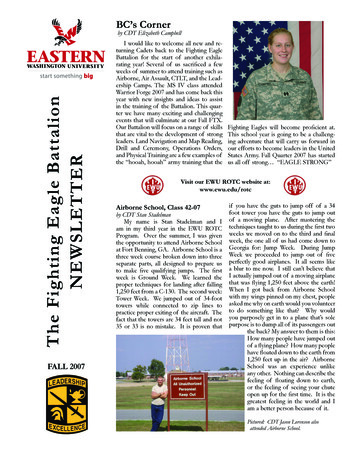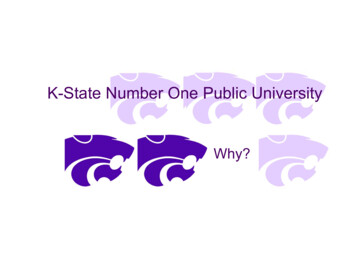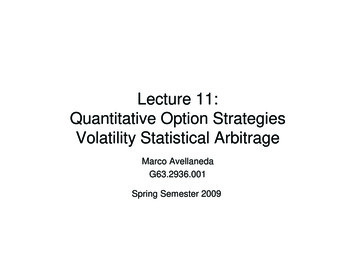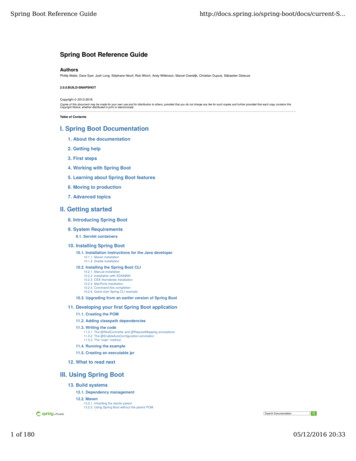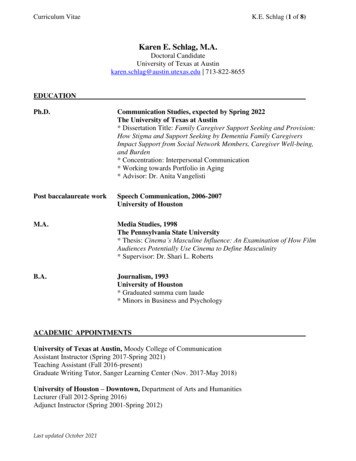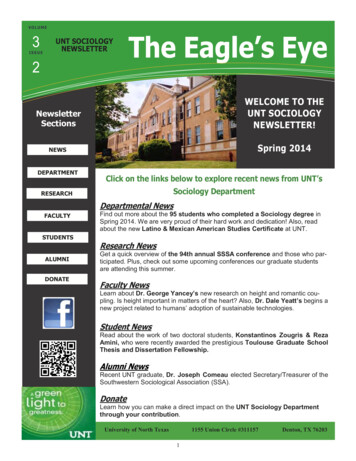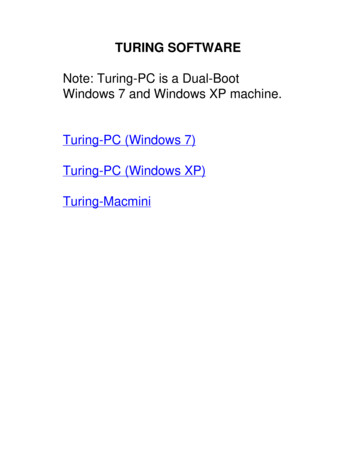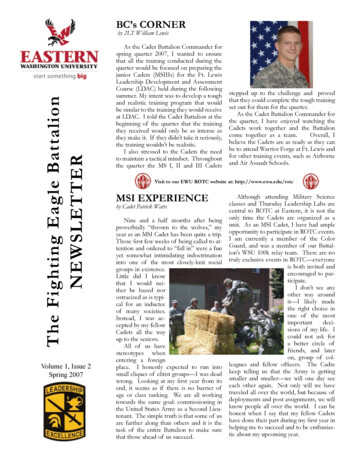
Transcription
BC’s CORNERThe Fighting Eagle BattalionNEWSLETTERby 2LT William LewisVolume 1, Issue 2Spring 2007As the Cadet Battalion Commander forspring quarter 2007, I wanted to ensurethat all the training conducted during thequarter would be focused on preparing thejunior Cadets (MSIIIs) for the Ft. LewisLeadership Development and AssessmentCourse (LDAC) held during the followingsummer. My intent was to develop a toughand realistic training program that wouldbe similar to the training they would receiveat LDAC. I told the Cadet Battalion at thebeginning of the quarter that the trainingthey received would only be as intense asthey make it. If they didn’t take it seriously,the training wouldn’t be realistic.I also stressed to the Cadets the needto maintain a tactical mindset. Throughoutthe quarter the MS I, II and III Cadetsstepped up to the challenge and provedthat they could complete the tough trainingset out for them for the quarter.As the Cadet Battalion Commander forthe quarter, I have enjoyed watching theCadets work together and the Battalioncome together as a team.Overall, Ibelieve the Cadets are as ready as they canbe to attend Warrior Forge at Ft. Lewis andfor other training events, such as Airborneand Air Assault Schools.Visit to our EWU ROTC website at: http://www.ewu.edu/rotcMSI EXPERIENCEby Cadet Patrick WattsNine and a half months after beingproverbially “thrown to the wolves,” myyear as an MSI Cadet has been quite a trip.Those first few weeks of being called to attention and ordered to “fall in” were a funyet somewhat intimidating indoctrinationinto one of the most closely-knit socialgroups in existence.Little did I knowthat I would neither be hazed norostracized as is typical for an inducteeof many societies.Instead, I was accepted by my fellowCadets all the wayup to the seniors.All of us havestereotypes whenentering a foreignplace. I honestly expected to run intosmall cliques of elitist groups—I was deadwrong. Looking at my first year from itsend, it seems as if there is no barrier ofage or class ranking. We are all workingtowards the same goal: commissioning inthe United States Army as a Second Lieutenant. The simple truth is that some of usare farther along than others and it is thetask of the entire Battalion to make surethat those ahead of us succeed.Although attending Military Scienceclasses and Thursday Leadership Labs arecentral to ROTC at Eastern, it is not theonly time the Cadets are organized as aunit. As an MSI Cadet, I have had ampleopportunity to participate in ROTC events.I am currently a member of the ColorGuard, and was a member of our Battalion’s WSU 100k relay team. There are notruly exclusive events in ROTC—everyoneis both invited andencouraged to participate.I don’t see anyother way aroundit—I likely madethe right choice inone of the mostimportantdecisions of my life. Icould not ask fora better circle offriends, and lateron, group of colleagues and fellow officers. The Cadrekeep telling us that the Army is gettingsmaller and smaller—we will one day seeeach other again. Not only will we havetraveled all over the world, but because ofdeployments and post assignments, we willknow people all over the world. I can behonest when I say that my fellow Cadetshave done their part during my first year inhelping me to succeed and to be enthusiastic about my upcoming year.
WSU 100KRelay RaceApril 2007Our team finished infourth place.Left to Right:Chris Obrine, Levi Floeter,Patrick Watts. NicholasCharlton, James Appel,Veronica Neeley, AmberEllis and Blaine Powers.Airborne SchoolAttendeesSeptember 2007CDT Jason LorensonCDT Rosalba OrozcoCDT Blaine PowersAir Assault SchoolAttendeesAugust 2007CDT Veronica NeeleySeptember 2007CDT Brian JohnsonCDT Stephen RobinsonAnnual SpringAwards CeremonyCTLT* AttendeesMAY 2007August 2007CDT Elizabeth CampbellCDT Nicolas PotterCDT Erin PriestBG (R) Neal Sealockpresents The Military Orderof the World Wars Award toCadet Joshua Decker.* Cadet Troop Leadership TrainingThe Spring FTX is the culmination of all the tacticaltraining that the Cadets have been exposed to throughout the2006-2007 school year. For MSIII Cadets, this FTX was the lasttraining event in preparation for Warrior Forge 2007. WarriorForge is the most important training event for the MSIII cadets.The 33-day training event, held at Ft. Lewis, WA, incorporatesa wide range of patrolling events designed to develop andevaluate leadership ability. The MSI and MSII Cadets weregiven the opportunity to practice their warrior tasks and drillsas well as learn, through observation, the components ofgood leadership. This final training event sharpened skills andinspired Cadets to work hard to stay motivated throughout thesummer in preparation for the 2007-2008 school year.SPRING 2007 FTXby Cadet Bryan OdonnellThe Cadets of the Fighting Eagle Battalion recentlyparticipated in the Spring Field Tactical Exercise (FTX) from18 – 20 May 2007. The three-day, two-night training eventbegan with an air assault operation in which MSIII Cadetswere transported by UH-1 helicopters to the Seven MileMilitary Reservation. The training exercise included twonights of tactical patrol base operations, a series of night landnavigation practical exercises, and one day land navigationpractical exercise. However, the most physically and mentallychallenging portion of the FTX was the platoon patrollingmissions. During these missions, MSIII Cadets lead platoonsized elements in tactical missions such as ambushes, knockout bunker missions, reconnaissance patrols, and traffic controlpoints. The Cadets were further challenged by “variables”which included media and civilians on the battlefield.2
First DutyAssignments2LT Bryce BrownCorps of Engineers (RC)Ft. Wainwright, AK2LT Susan BrownNurse CorpsFt. Wainwright, AK2LT Nicholas CharltonSignal CorpsFt. Hood, TX2LT Mark HardeeSignal Corpsdetailed InfantryFt. Campbell, KYCDT Parker HathawayOrdnanceKorea2LT Charles HinesSignal Corpsdetailed Field ArtilleryFt. Hood, TX2LT William LewisAviationFr. Rucker, AL2LT Erik LokkinsField ArtilleryFt. Lewis, WA2LT Benjamin NeeleyArmorFt. Bliss, TX2LT Caleb NewbillSignal Corpsdetailed InfantryFt. Bragg, NC2LT Amanda RowseAir Defense ArtilleryFt. Hood, TXGRADUATIONby 2LT Charles HinesComing to college and joining theROTC program after serving as an enlisted soldier in the active component of theU.S. Army, was a significant change forme. I was used to a very strict schedulewhich included physical training five timesa week amd working long hours until thedaily mission was complete. In addition,I had a senior non-commissioned officer always telling me what needed to getdone and in return, I would delegate tomy subordinates how to get the job done.When I became a college studentthat all changed. No longer did I havenon-commissioned officers telling mewhat to do. Nor did I have junior soldiers who I was responsible for. I havelearned that success in college is basedon your ability to manage your time anddevelop solid study habits and interpersonal and communication skills. Overthe course of the academic year, I havegrown in my ability to lead, manage andcommunicate to others. During fall quarter, I was assigned as the Battalion training and operations officer (S3). In winterquarter, I held the position of Cadet Battalion Commander. For spring quarter, Ibecame the Battalion intelligence officer(S2). I also attended and passed Warrior Forge 2006 and Air Assault School.Each of these positions and schools hashelped make me the officer I am today.Graduation day has finally come andgone. Attending EWU for two years,completing my bachelor degree andworking toward my commission in theArmy is now over. There were timesof stress, lack of confidence and doubtsabout whether I could pull this off. Butwith my wife’s support and the help fromCadre and other Cadets, I was able toachieve all my goals. Having such a strongsupport group really helped me out.These have been fast-moving twoyears, with so many outstanding memories. Looking back and thinking abouthow people have grown and changedwithin these two years is amazing. Iwish the best of luck to all those Cadetsworking toward their degrees and commissioning. With hard work and commitment they too will wear the gold bars of aSecond Lieutenant.Visit to our Cadet Command website at: http://armyrotc.com/edu/easternwa/index.htmGEORGE C.MARSHALL ANNUALAWARD CEREMONYby 2LT Caleb NewbillEvery year, for the past 30 years, theGeorge Marshall Foundation has held anannual award ceremony in Lexington, VAfor Army ROTC Cadets. The George C.Marshall award is presented to the topCadet from every Army ROTC Battalionacross the country. This year 272 Cadetsreceived this award and I was fortunateenough to be one of them.During the seminar, we had the opportunity to hear from numerous distinguished people who are or have servedour country in many different capacities.Speakers included Acting Secretary ofthe Army, the Honorable Pete Geren, theCommanding General of the US Army3Training and Doctrine Command (TRADOC), GEN William Wallace, Undersecretary of Homeland Security, the Honorable George Foresman and many morerenowned persons.Each Cadet had the opportunity to attend three roundtable discussions whichwere led by diverse and very experiencedpeople. Also, every Cadet attended a discussion on the Role of the Platoon Leader and Platoon Sergeant and two otherdiscussions, which dealt with national security issues. The national security issuesincluded Homeland Security, Conflict inthe Persian Gulf, Officer’s Ethics, Mediaand the Battlefield, Peacekeeping and theU.S. Military, among other topics. Thisseminar provided me with the opportunity to meet other Cadets that I will servewith in the future. I left this conferencemore motivated to be an Army Officerthan I ever have been before.
MILITARY BALL 2007by Cadet Steven DewhittThe Military Ball this year was a great experience for bothCadets and their guests. It was also great to see so many of ourparents attend this special event.The Ball was held at the Mirabeau Park Hotel in SpokaneValley, WA on 11 May. The Hotel was a great setting for theMilitary Ball as it provided an elegant environment for theevent. The guest speaker for the ball was The HonorableTom Norris. Mr. Norris is a retired U.S. Navy SEAL who wasawarded the Medal of Honor for his ground rescue of twodowned pilots in Quang Tri Province, Vietnam (the man whothe movie Bat 21 is based on).One of the main focal points of the night were the Seniors.All of the soon-to-be-commissioned senior Cadets were recognized in front of the entire crowd. In addition, there wasa slide show and a cake cutting ceremony that honored them.The night also included a series of skits put on by the Cadets.The freshman and sophomores presented skits that pokedfun at the upper classmen, while the juniors and seniors skitsteased the Cadre. The evening concluded with pictures, dancing, and music.Overall, the EWU Army ROTC Military Ball was a greatsuccess. The success of the event was due in large part to allthe hard work and effort made by numerous Cadets who participated in the planning and execution of the Ball. I have nodoubt that all of the Cadets are looking forward to next year’sceremony.LTC M. David MilletEWU ROTC PMSand The HonorableThomas R. Norris,USN (R) CongressionalMedal of HonorRecipientCadets Blaine and Blair Powers with parents.LTC (R) JERRY MELLICK (1967)Currently works at Anheuser-Busch2LT William Lewisand fiance Kirstin PriceInformation below taken from email from LTC (R) Mellick dated May 23, 2007:I’m still actively involved with the Army even after 40years from graduation and commissioning from Eastern’sROTC Program. I fly Hueys for the Army Aviation Heritage Foundation, and we were the main air show event atthe Week Of Eagles at Ft. Campbell, May 2007. The 101stAirborne Division thought we were “Cool Looking OldDudes. In addition to our Viet Nam shows and the Hueyrides we give at air shows, we are under contract from the USArmy Recruiting Command to perform at Army designatedair shows to assist with Army recruiting. We use a four shipCobra team and the aircraft are painted gloss black with allof the Army logos and signage.CDT Katie Reidlights a candle forthe fallen soldier.4
ALUMNI UPDATESLTC (R) EDWIN G. HARVILL (1963)Retired August 1986. Retired from Pierce Transit 2005. Doing volunteer work with kindergarten reading program at Tillicum Elem.School. Also spends time woodworking with exotic woods.children to immigrate to the US. We’re now in the final weeks of that process, and soon -- if everything works out -- they will come to Puyallup andlive with my family until they get settled into a home of their own.I never imagined my 20 years in the Army would result in opening myhome and caring for a family from Iraq, but that’s what my family is excitedly preparing to do.In my DA civilian job at Fort Lewis, I am a senior spokesman for thepost. Currently, I talk to reporters almost every day about the Lt. Watadacase. A simple Google News search with my name “Joe Piek” or “JosephPiek” will tell you what story I’m talking about at Fort Lewis today.If you’re ever looking for a visiting guest speaker to talk about Iraqexperiences, Army Public Affairs or Stryker Brigades, let me know.All the best to the Fighting Eagle Battalion,Joseph PiekLTC (R) ROBERT J. STOKKE (1965)Currently the Personnel Records Manager at Microsoftin Redmond, Washington.BERT LOMAX (1967)Recently retired from U.S. Export/Import Bank in Washington D.C.BILL THOMPSON (1967)Attended ROTC classes 1960-62, a participant of AUSA andROTC Drill Team. Enlisted in 1962, served until 1965. Returnedto EWU and received degree in 1967.LTC (R) STEVE EPPERSON (1973)Retired from the USAR in 2001 with over 30 years service.Currently a VA vocational rehabilitation counselor stationed atFt. Lewis working with disabled veterans.COL ALEX MOMB, USAF (1988)Currently resides in Bothell Washington. Contributor to ROTCFoundation. Son enrolled in ROTC.LTC RICH YADACurrently a Transportation Officer still on active duty withassignment as the S3, 10th Support Group, Okinawa, Japan.LTC (R) JOE EMEHISER (1974)Currently the Ft. Benning Coordinator for GMC at Columbus,a Liberal Arts Junior College and lives in the Ft. Benning area.DAVE CLARK (1991)Served on active duty until March 1997, stationed in Germany andFt. Knox. Recruited by US West Communications (now QwestCommunications) as an Installation/Maintenance Supervisor inSpokane after working in San Diego at a software firm. Resignedhis commission Summer 2001 and is currently a Sr. Design Engineer in the Construction/Engineering Department.COL JAMES PIERSON (1979)Currently the Chief of Staff of the 335th Signal Command (Theater), Atlanta Georgia. Served as the Signal Operations Officerin the V Corps Tactical Command Post during the entry phase ofOperation Iraqi Freedom, as well as Signal Operations Officer forCJTF-7 Headquarters co-located with the Coalition ProvisionalAuthority.LTC (R) MARILYN ‘SAM’ LEITZ (1999)COL (R) FRANK P. TODD (1980)Currently working in HQDA G6 as an FA40 (Space Operations)focused on Space (both satellite communications and Intelligence,Surveillance, and Reconnaissance (ISR) capabilities) and Airborne(both unmanned aerial vehicle communications relay and ISR capabilities) for the last four years. Served as a Signal Officer and NCOfor 25 years. Currently resides in Virginia.CPT (R) JIM VAN NOSTRAND (1981)Attended Infantry and Airborne schools at Fort Benning, servedin 1st Infantry Division (FWD) in Germany 1984-86. Served a fewmore years in the Guard in Oregon and Pennsylvania. Currentlyresides in Maryland and is the web editor at McClatchy WashingtonBureau.LTC JOSEPH J. PIEK (1985)Public Affairs Officer for the first Stryker Brigade in Iraq, Oct.2003. Retired 30 June 2005. Currently, External CommunicationsChief at Ft. Lewis and lives in Puyallup, Washington.LTC (R) Leitz receiving the 2006 Meritorious Unit Citation (MLCC)CPT BRIDGET A WETZLER (1999)Formerly 2LT Liles. Currently stationed at Ft. Lewis Washington,working in the Western Region CDT Command HQ S2 Shop as anOperations Officer.(Excert from email )While serving as a Public Affairs Officer in Iraq from Oct 2003 - Aug2004, with 3rd Bde, 2ID (Stryker Brigade Combat Team) and with TaskForce Olympia in Mosul, I had a team of six Iraqi translators workingwith me. One of my translators, Samir, was killed by insurgents in Sept‘04, shortly after I returned from Iraq. After that, the other translatorsquit working with Task Force Olympia for their own safety, except for one-- Ahmed. Eventually, the risk of working with U.S. forces became to great,and Ahmed and his family went into hiding. I have been working with Sen.Patty Murray’s office for 2 years on helping Ahmed, his wife and threeCPT (R) CHUCK WAGONBLAST (2000)No longer with the 201st, in the IRR now, living in Spokane. IsChief Operations Officer/Project Manager at ProVolve SolutionsInc. Received MS in 2000.DO YOU HAVE NEWS TO SHARE?Send us an email at: ROTC@mail.ewu.edu5
Non-Profit Org.U.S. POSTAGEPAIDDepartment of Military Science202 Cadet HallCheney WA 99004-2429Eastern WashinngtonUniversityhttp://www.ewu.edu/rotcNOTE FROM THE PMSby LTC M. David Millet (dmillet@mail.ewu.edu)It has been another successful academic year here at Eastern Washington University. By the end of this school year theEWU ROTC program will have commissioned 11 new Lieutenants into the U.S. Army; serving in Combat Arms, CombatSupport and Combat Service Support branches. These Officers will serve in many posts throughout the country, representingthis fine University with honor and pride. They will carry on the traditions established by generations before them.During the summer months we will also send 18 Cadets to FT Lewis, WA for “Warrior Forge” – the Leadership DevelopmentCourse, where over 4000 Cadets from across the country will come to train. This is an important step in the commissioningprocess for these young Warriors. These Cadets will come back to campus in the fall ready to take responsibility for training andteaching their fellow Cadets. We will also send Cadets to Air Assault and Airborne schools this summer. So I know we will havemany great accomplishments to report in our next newsletter.Lastly I would like to thank BG (R) Fred Wong and Dean Vickie Shields for allowing me to travel to Washington D.C.last spring to meet with a small group of EWU ROTC Alumni and spread the word on what great work our Cadets areaccomplishing. They were all amazed with how much is demanded of Cadets in today’s ROTC program and how importantGPA and leadership assessment are in the commissioning process. And I did assure them that “Goofy’s Bar” was still alive andwell as a local watering hole in Cheney.Please continue to share your Alumni information with us – we enjoy seeing current photos of what our EWU ROTCAlumni are up to today.ALUMNI AND FRIENDS IN WASHINGTON, D.C.Front Row: LTC (R)Marilyn ‘Sam’ Lietz, ElaineLomax, Dr. Vickie Sheilds,EWU Dean; VictoriaWong, ‘73 Middle Row:BG (R) Fred Wong, ‘64,‘73; LTC David Millet,EWU ROTC PMS BackFow: COL (R) Stan Johnson, ‘59; CPT (R) DanBeyer, ‘74; BG (R) NealSealock, ‘74; CPT (R) JimVan Nostrand, ‘81; BertLomax, ‘67; Mike Westfall,EWU VP for Advancement Not Pictured: PhilKiever, ‘03.
ROTC program after serving as an enlist-ed soldier in the active component of the U.S. Army, was a signicant change for me. I was used to a very strict schedule which included physical training ve times a week amd working long hours until the daily mission was complete. In addition, I had a senior non-commissioned of-

